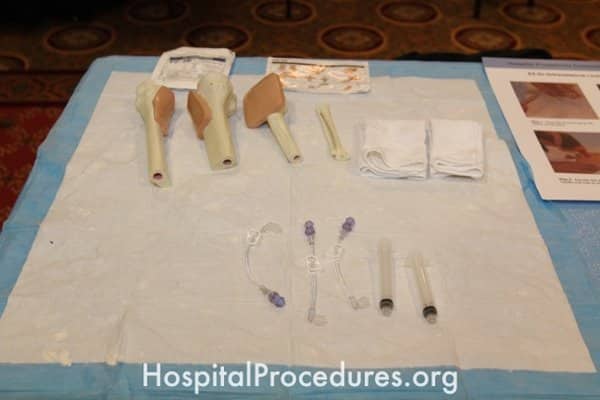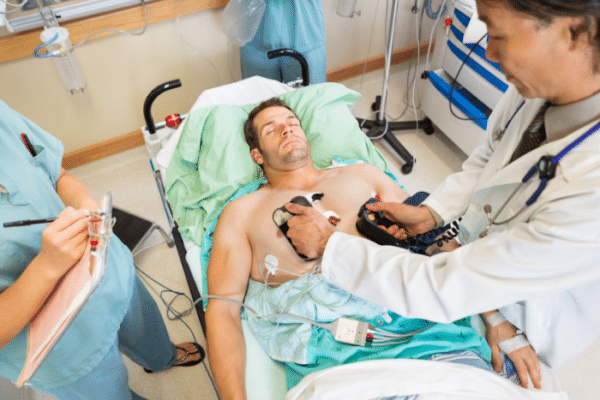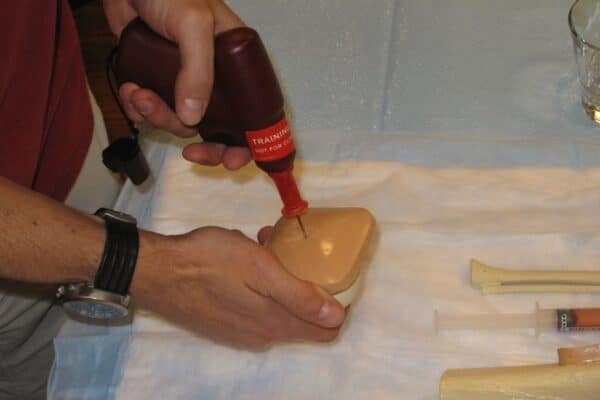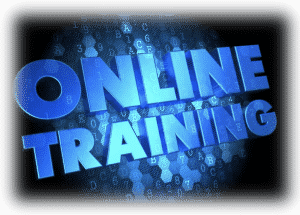Intraosseous line placement is an alternative to central venous access, ultrasound-guided central line placement or ultrasound-guided peripheral IV access for patients with difficult vascular access.

What you will Learn in the Intraosseous Line Course
The intraosseous line placement course will teach clinicians how to use the EZ-IO drill to place intraosseous lines in the proximal tibia, distal tibia and proximal humerus using simulated bones. The course covers the indications for intraosseous line insertion including difficult venous access, vasopressor therapy and the need for immediate venous access. Technique and contraindications to intraosseous access will be taught as well as removing intraosseous needles.
The HPC Hospitalist and Emergency Procedures course will teach you how to perform intraosseous line placement in addition to endotracheal intubation, stylet-guided intubations, laryngeal mask airway (LMA) placement, King tube placement, or fiberoptic intubations. central venous access, ultrasound-guided central line placement, ultrasound-guided peripheral IV access, arterial lines, POCUS exams (RUSH exams and E-FAST exams), thoracentesis, paracentesis, lumbar punctures, chest tube placement, pigtail catheter placement, needle thoracostomy, procedural sedation, and ventilator management.
Why you should choose us for your Intraosseous Line Course
Our IO line placement training is a component of our live Hospitalist and Emergency Procedures CME course which teaches clinicians how to perform the 20 most essential procedures needed to work in the ER, ICU, and hospital wards.
Take your skills to the next level with our comprehensive Intraosseous Line Course!
Intraosseous Line Placement Photos
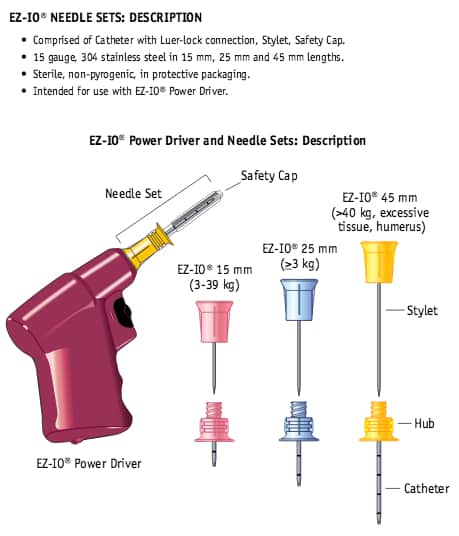
EZ-IO Course trains students in:
- Indications for intraosseous line (EZ-IO) placement
- Contraindications for intraosseous line placement
- Complications of a intraosseous line placement
- Equipment for intraosseous line placement
- Proper locations for intraosseous line placement
- Technique for intraosseous line insertion
- Removing intraosseous lines
- Coding for intraosseous line placement
Intraosseous Line Placement Blogs
Intraosseous Lines: Decreased ROSC Rates and Survival Compared to Peripheral IV Access
Basic Emergency Procedures You Should Know
Live CME Course vs Online CME Course. Which One to Choose?
Looking To Work in the ER? Here Are Its Benefits, Challenges, and What To Expect
Procedural Competency in Academic Emergency Medicine Attending Physicians
Hospitalist and Emergency Procedures CME Courses Available
Register HERE 21 days before the course to SAVE $50-150 and get the following:
- 12 month online access to Online CME course, procedure video bundle, instructional posters
- Indefinite online access to PDFs of all course lectures, course handouts, and HPC Adult Critical Care and Emergency Drug Reference Drug
2024-08b Hospitalist and Emergency Procedures Course – San Antonio, TX (Sunday ONLY)
Courtyard Marriott San Antonio Riverwalk Hotel
November 17, 2024
Live Course & Online Course
(Sunday ONLY)
Compare Registration Types
2024-08a Hospitalist and Emergency Procedures Course – San Antonio, TX (Saturday ONLY)
Courtyard Marriott San Antonio Riverwalk Hotel
November 16, 2024
Live Course & Online Course
(Saturday ONLY)
Compare Registration Types
2024-08 Hospitalist and Emergency Procedures Course – San Antonio, TX (WEEKEND)
Courtyard Marriott San Antonio Riverwalk Hotel
November 16-17, 2024
Live Course & Online Course
(Saturday & Sunday)
Compare Registration Types
2024-07b Hospitalist and Emergency Procedures Course – New Orleans, LA (Sunday ONLY)
Intercontinental New Orleans Hotel
October 20, 2024
Live Course & Online Course
(Sunday ONLY)
Compare Registration Types
2024-07a Hospitalist and Emergency Procedures Course – New Orleans, LA (Saturday ONLY)
Intercontinental New Orleans Hotel
October 19, 2024
Live Course & Online Course
(Saturday ONLY)
Compare Registration Types
2024-07 Hospitalist and Emergency Procedures Course – New Orleans, LA (WEEKEND)
Intercontinental New Orleans Hotel
October 19-20, 2024
Live Course & Online Course
(Saturday & Sunday)
Compare Registration Types
2024-06b Hospitalist and Emergency Procedures Course – Seattle, WA (Sunday ONLY)
Crowne Plaza Seattle Downtown Hotel
September 8, 2024
Live Course & Online Course
(Sunday ONLY)
Compare Registration Types
2024-06a Hospitalist and Emergency Procedures Course – Seattle, WA (Saturday ONLY)
Crowne Plaza Seattle Downtown Hotel
September 7, 2024
Live Course & Online Course
(Saturday ONLY)
Compare Registration Types
2024-06 Hospitalist and Emergency Procedures Course – Seattle, WA (WEEKEND)
Crowne Plaza Seattle Downtown Hotel
September 7-8, 2024
Live Course & Online Course
(Saturday & Sunday)
Compare Registration Types
2024-05b Hospitalist and Emergency Procedures Course – Denver, CO (Sunday ONLY)
Sheraton Denver Downtown Hotel
July 21, 2024
Live Course & Online Course
(Sunday ONLY)
Compare Registration Types

